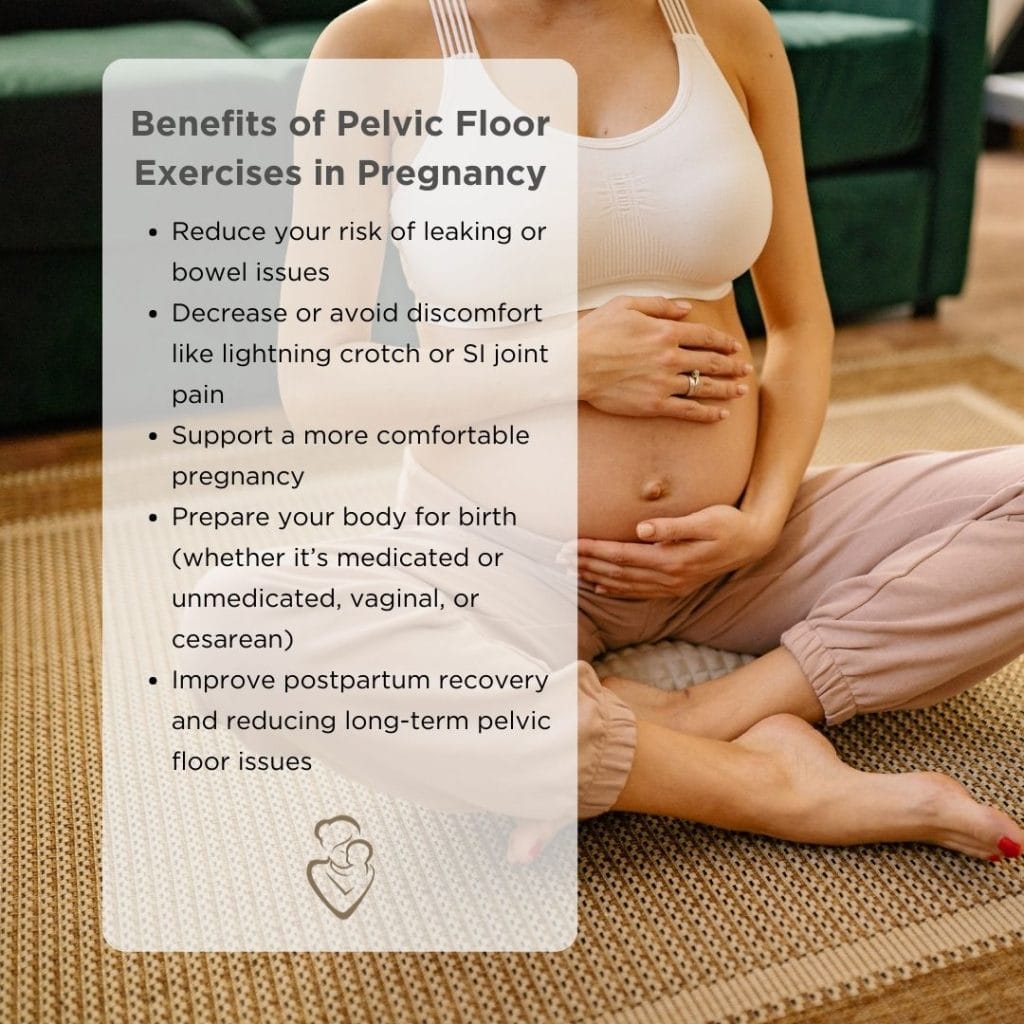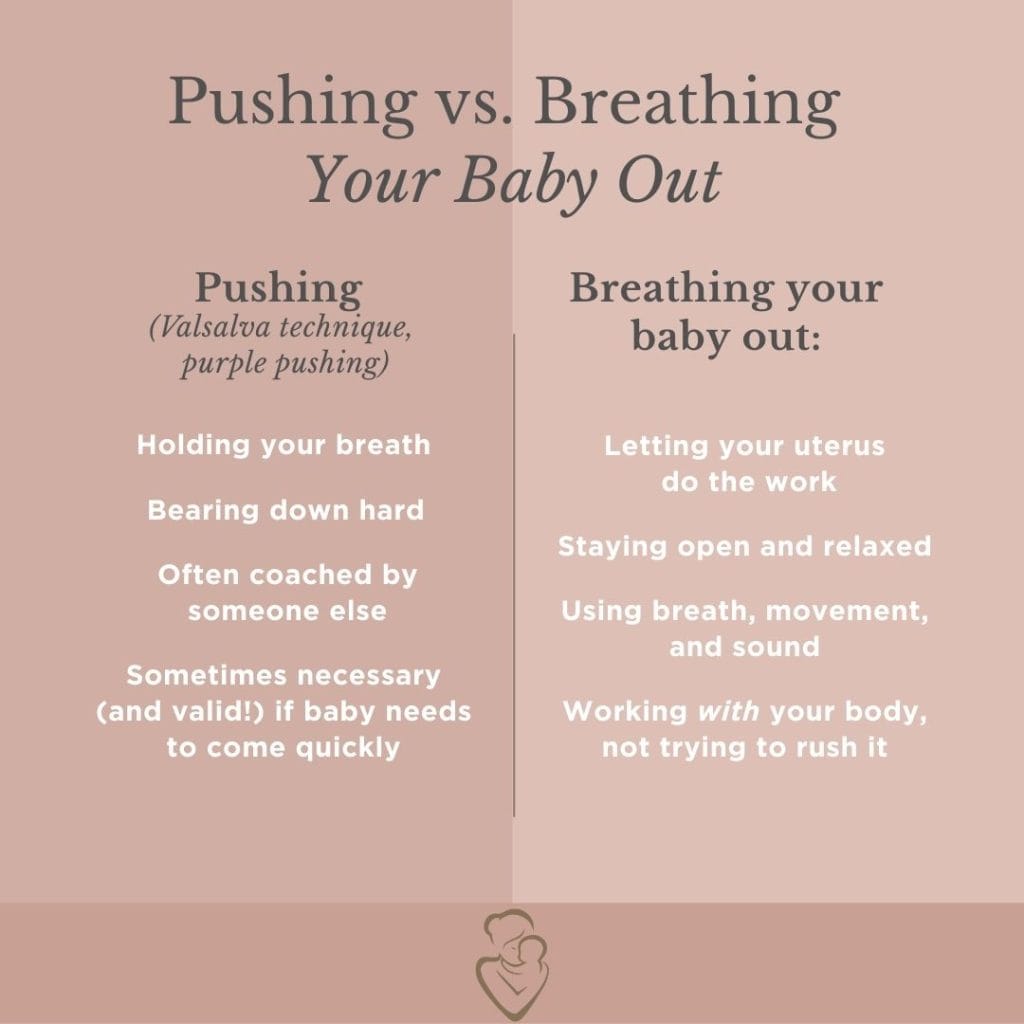

So much happens in your body during pregnancy — and sometimes, the pelvic floor gets left out of the conversation. But it shouldn’t.
Pelvic floor exercises in pregnancy are an incredible tool you can use to support your body before, during, and after birth. And no, I’m not talking about endless Kegels.
Let’s dive into what the pelvic floor really is and why learning to strengthen and relax it matters more than many people realize.
What Is the Pelvic Floor?
Your pelvic floor is a bowl of muscles (and tendons, ligaments, and nerves) that sits at the bottom of your pelvis. These muscles do a lot of big jobs: They help control your bladder and bowel, let you stand upright, contract when you orgasm, keep your internal organs in place — and they release to let your baby emerge during birth.
Clearly, your pelvic floor is kind of a big deal.
What Is Pelvic Floor Therapy?
Many people think pelvic floor therapy is just about those “down there” muscles. But the truth is, your pelvic floor connects to your entire body. That’s why true pelvic floor therapy isn’t isolated to just one area.
A good pelvic floor therapist looks at your whole body: how you move, how you breathe, how your muscles work together. We work to support everything from bladder control to sexual health, and yes, to help you prepare for birth and heal afterward.
For the record, anyone can use the title “pelvic floor therapist” on their business card. To make sure you get safe, appropriate, and quality care, look for a licensed physical or occupational therapist for your pelvic floor therapy.
Who Should Get Pelvic Floor Therapy?
Anyone having issues with bowel, bladder, or sexual function would likely benefit from strategic pelvic floor therapy. If you’re feeling pressure, like your organs are falling toward your vagina or rectum, or you have pain in your pelvis — that’s also a sign you could benefit. And if you’re planning to become pregnant, are already pregnant, or have ever birthed a child, pelvic floor therapy can be a game-changer for your health and quality of life.
In a perfect world, you’d start seeing a pelvic floor therapist before you got pregnant. But that isn’t always feasible. In reality, even if I meet you in your second or third trimester, there’s still so much we can do to help you feel strong, capable, and prepared for the birth experience.
Why Pelvic Floor Exercises in Pregnancy Matter
Besides strengthening — which is important — pelvic floor exercises help you learn to release and relax those muscles. It’s a skill that becomes essential during birth, no matter how you’re planning to do it.
Benefits of pelvic floor exercises in pregnancy include:
- Reducing your risk of leaking or bowel issues
- Decreasing or avoiding discomfort like lightning crotch or SI joint pain
- Supporting a more comfortable pregnancy
- Preparing your body for birth (whether it’s medicated or unmedicated, vaginal, or cesarean)
- Improving postpartum recovery and reducing long-term pelvic floor issues

When to Start Pelvic Floor Exercises in Pregnancy
The biggest reason I wish all women could start pelvic floor therapy prior to pregnancy is this: The first trimester can be challenging for many women, so it’s helpful to have established care already. No one wants to search for a therapist and figure everything out while tired and nauseated!
That said, don’t stress if you can’t start until your first, second, or even third trimester. There’s still so much we can do throughout your pregnancy! Here’s where we typically focus during each stage:
Pre-Pregnancy + First Trimester: Strength
We build as much full-body strength as possible before major pregnancy changes begin. The more strength you have early in pregnancy, the more you can carry those gains into the second trimester.
Second Trimester: Maintain + Modify
We continue working on full-body strength, with some modifications based on symptoms and how much control you have over your core.
Third Trimester: Prepare for Birth
While maintaining strength, our focus truly shifts at this point and we start prepping your body for the main event. That means making lots of modifications (hello, growing belly), learning how to relax your pelvic floor, and introducing some perineal stretching.
How to Exercise Your Pelvic Floor in Pregnancy
When people think about pelvic floor exercises in pregnancy, they usually think “Kegels.” But here’s the thing: I almost never recommend Kegels.
The pelvic floor doesn’t work in isolation. It’s part of a whole system, so I don’t train it in isolation either. Instead, we focus on full-body movements that naturally engage the pelvic floor — like squats, deadlifts, and bridges — because that’s how it works in real life.
I always tailor pelvic floor exercises to your trimester, your current fitness level, your symptoms, and even how many pregnancies you’ve had. First pregnancies look different than third or fourth pregnancies, especially when it comes to how quickly things like abdominal separation show up.
That said, I personally like to target a few core areas for almost everyone:
- Deep core muscles (especially those below your belly button)
- Hip rotators (muscles that rotate your hips in and out)
As coning and doming start to appear in the third trimester, we modify to gentler exercises to reduce the risk of a hernia. At this point, your pelvic floor exercises become less about maintaining strength through pregnancy and more about getting baby into a good position and ensuring your body is ready for birth.
A Note on Pushing vs. Breathing Your Baby Out
During labor, there’s a big difference between pushing your baby out and breathing your baby down. Let’s talk about it.
Pushing (Valsalva technique, purple pushing):
- Holding your breath
- Bearing down hard
- Often coached by someone else
- Sometimes necessary (and valid!) if baby needs to come quickly
Breathing your baby out:
- Letting your uterus do the work
- Staying open and relaxed
- Using breath, movement, and sound
- Working with your body, not trying to rush it
In labor, your body will want to run from the intensity. That’s why one of the most important things I teach is how to lengthen your pelvic floor muscles on purpose. If you can master that, you’ll be able to meet labor with presence instead of panic — and your recovery will thank you.

When you have an epidural, it can be harder to connect with your body. To help, I like to pose this question: “What would your body be doing if it weren’t medicated?” You’d be moving, vocalizing, and working with your body. So, even if you don’t feel the need to, practice what you’d likely be doing anyway.
Your body might respond in one of two extremes during labor:
- Kegeling — tensing up and fighting the process
- Pushing/Valsalva — bearing down, holding your breath with a closed glottis (like pushing when constipated)
What we want is to find a middle ground between the two. You’re not fighting your body, but also not rushing. You’re staying vocal, breathing low, intentionally relaxing your pelvic floor, and getting out of your body’s way so your baby can be born.
Final Thoughts on Pelvic Floor Exercises in Pregnancy
If I could leave you with one thing, it’s this: Knowing how to lengthen and relax your pelvic floor is the most important technique I teach.
Even if you have an epidural and can’t feel a thing (I’ve been there!), knowing how to consciously relax your pelvic floor muscles still impacts your labor and recovery. In my case, I even asked my midwife to check if I was releasing properly because I couldn’t feel a thing — but I’d practiced enough to know what my body should be doing. And it made a world of difference.
Pelvic floor exercises in pregnancy aren’t about squeezing hard and hoping for the best. They’re about building a connection to your body so that, when it counts, you can trust yourself to open, release, and let your baby be born.

Laura Gordey is a Doctor of Physical Therapy and the founder of Plus One Pelvic Health, where she supports women navigating pelvic health challenges. Her passion is rooted in both clinical expertise and personal experience, having walked through pelvic dysfunction, three birth journeys, and perinatal mood disorders herself. Laura holds advanced training in Pregnancy and Postpartum Corrective Exercise and Somatic Experiencing, with a focus on helping women heal, move confidently, and thrive in the bodies God designed.
Outside of her practice, Laura enjoys time with her family and continuing to learn alongside the women she serves.
